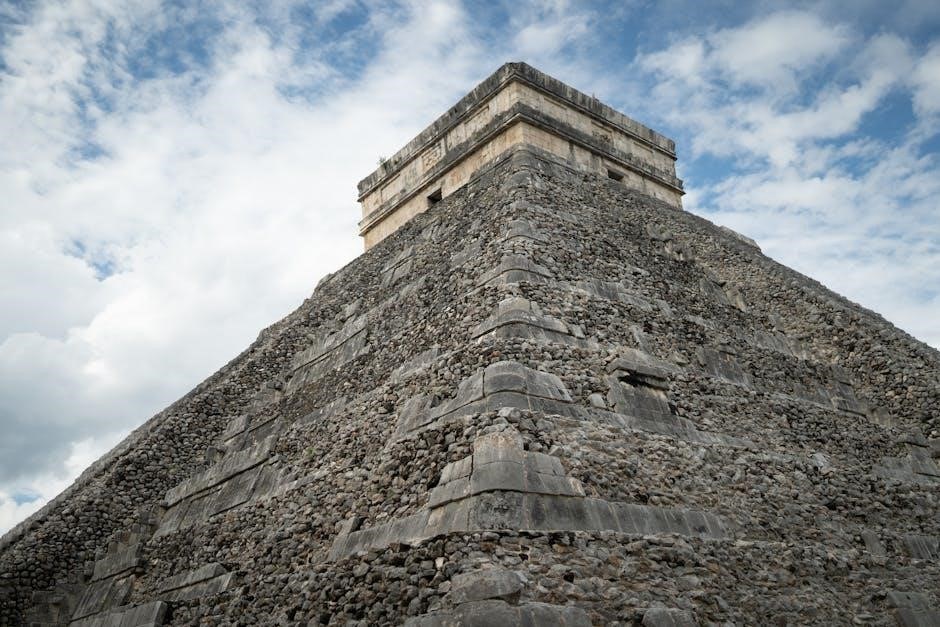HMH Modern World History Textbook PDF: An Overview
The HMH Modern World History textbook is available digitally‚ offering convenient access to its content. You can find PDF versions of textbook chapters online‚ like Chapter 1: The First Humans (53MB) and Chapter 2: Western Asia and Egypt (96MB).
Availability of HMH Modern World History Textbook in PDF Format
The digital accessibility of the HMH Modern World History textbook is a significant advantage for students and educators alike. PDF versions of the textbook‚ or specific chapters‚ are often available online for download. This digital format provides flexibility‚ enabling users to access the material on various devices‚ including computers‚ tablets‚ and smartphones. This ease of access is particularly beneficial for students who prefer studying on digital devices‚ or those needing to access the textbook outside of the classroom.
Keep in mind that Houghton Mifflin Harcourt Publishing Company retains the title to the materials if received as examination copies free of charge. Furthermore‚ the availability of the complete textbook in PDF format may vary due to copyright restrictions. However‚ individual chapters or supplementary materials are more readily accessible. Always ensure that you are accessing these resources from legitimate sources to respect copyright laws.
Accessing Digital Versions and Online Resources
Accessing digital versions of the HMH Modern World History textbook and related online resources can significantly enhance the learning experience. To locate these resources‚ start by checking the official Houghton Mifflin Harcourt website‚ which often provides digital textbooks and supplementary materials. Educational platforms and online libraries are also excellent sources.
When searching‚ use specific keywords such as “HMH Modern World History PDF‚” “digital textbook‚” or the specific chapter you need. Many websites offer chapter-specific PDFs that you can download directly. Additionally‚ explore online resources like guided reading workbooks in PDF form‚ which are compatible with various mobile devices.
Remember to verify the legitimacy of the source before downloading any materials to avoid copyright infringement. By leveraging these digital tools‚ students can engage with the textbook content in a more interactive and accessible manner‚ fostering a deeper understanding of modern world history.

Key Content Areas in HMH Modern World History
Chapters 1-3 likely cover early civilizations‚ while the textbook as a whole explores modern world history. It also includes patterns of interaction and other key historical themes.
Early Civilizations: A Focus on Chapters 1-3
Chapters 1 through 3 of the HMH Modern World History textbook delve into the fascinating realm of early civilizations. Expect comprehensive coverage of foundational societies‚ potentially exploring their origins‚ development‚ and lasting impact on subsequent historical periods. These chapters may address the unique characteristics of different early civilizations‚ such as their social structures‚ political systems‚ economic activities‚ and cultural achievements.
Content could include detailed examinations of Mesopotamia‚ ancient Egypt‚ the Indus Valley Civilization‚ and early China. Emphasis might be placed on key developments like the rise of agriculture‚ the emergence of cities‚ and the formation of early states. These chapters provide a crucial foundation for understanding the broader sweep of world history.
You can expect the textbook to offer insights into the religious beliefs‚ artistic expressions‚ and technological innovations of these ancient cultures‚ providing a comprehensive overview of their contributions to human civilization. It is very important to have a good understanding of these early civilizations!
Modern World History: Patterns of Interaction
“Modern World History: Patterns of Interaction” is a key theme within the HMH textbook‚ emphasizing the interconnectedness of global events and cultures. This section likely explores how different societies have influenced one another through trade‚ migration‚ conflict‚ and the exchange of ideas. It probably examines major historical periods and events through the lens of global interaction‚ highlighting the complex relationships between nations and regions.
Expect content on topics such as colonialism‚ imperialism‚ globalization‚ and the rise of international organizations. The textbook aims to provide a nuanced understanding of how these interactions have shaped the modern world‚ fostering both cooperation and conflict. This perspective encourages critical thinking about the causes and consequences of global events‚ emphasizing the importance of understanding diverse perspectives.
The textbook covers the California Edition of “Modern World History Patterns of Interaction‚” published in January 2003 by Houghton Mifflin Company‚ focusing on comprehensive patterns of interaction.

Utilizing the Textbook for Educational Purposes
The HMH Modern World History textbook includes assessments that measure student understanding of historical content. These assessments help educators gauge student progress and identify areas needing further attention in the curriculum.
Assessments and Measuring Student Progress
The HMH Modern World History textbook provides various assessments designed to measure student progress effectively. These assessments cover historical content and promote inquiry-based learning through document analysis. The textbook’s instructional materials include tools for evaluating student understanding of key concepts and historical events. These assessments offer educators insights into student learning‚ helping them tailor instruction.
Furthermore‚ the textbook helps in measuring student progress by evaluating their ability to analyze primary sources and engage in historical thinking. The assessments measure proficiency in understanding patterns of interaction and historical inquiry. With these tools‚ teachers can track student development and provide targeted support.
Activities and Lesson Plans Associated with the Textbook
The HMH Modern World History textbook is complemented by a range of activities and lesson plans designed to enhance student engagement and understanding. These resources offer educators structured frameworks for teaching complex historical topics. The activities encourage critical thinking and active participation in the learning process. Lesson plans often incorporate primary source analysis and group discussions.
Also‚ educators can access free activities calendars‚ providing fun and engaging lessons for commemorating events throughout the year. These resources support the implementation of the textbook’s content and foster a dynamic classroom environment. The lesson plans align with the textbook’s content‚ ensuring a comprehensive and cohesive learning experience;

Supplemental Resources and Materials
To enhance the learning experience‚ supplemental resources are available. These include guided reading workbooks in PDF form‚ accessible on mobile devices. These resources help guide students through complex material effectively.
Guided Reading Workbooks and PDF Forms
Guided Reading Workbooks are valuable supplemental materials designed to accompany the HMH Modern World History textbook. These workbooks are often available in PDF format‚ making them easily accessible on various devices‚ including iPads‚ Nooks‚ and Kindles. The purpose of these workbooks is to guide students through the textbook’s content‚ reinforcing key concepts and promoting a deeper understanding of the material.
The PDF format allows for convenient download and use‚ enabling students to study anytime‚ anywhere. These workbooks typically include activities‚ questions‚ and summaries that align with the textbook chapters‚ helping students to actively engage with the material and improve their comprehension. By using Guided Reading Workbooks‚ students can enhance their learning experience and achieve greater success in their modern world history studies. Teachers find these resources invaluable for differentiating instruction and supporting diverse learners in their classrooms. The availability of PDF forms ensures easy distribution and integration into digital learning environments.
Document-Based Activities and Historical Inquiry
Document-based activities are integral to historical inquiry‚ encouraging students to analyze primary and secondary sources. These activities foster critical thinking‚ evidence-based reasoning‚ and a deeper understanding of historical events. The HMH Modern World History textbook often incorporates document-based questions and activities‚ prompting students to engage with historical documents and form their own interpretations.
These activities may involve analyzing written documents‚ images‚ maps‚ and other artifacts to draw conclusions about the past. By examining diverse sources‚ students develop skills in source evaluation‚ contextualization‚ and historical perspective. Historical inquiry encourages students to ask questions‚ investigate evidence‚ and construct arguments‚ promoting a more active and engaging learning experience. Teachers can use these activities to assess student understanding of historical content and their ability to think critically about historical evidence. These skills are essential for success in history courses and for developing informed and engaged citizens.

Related Historical Topics and Context
Civilian internment during World War I represents a dark chapter in history. It highlights the impact of war on individual liberties and human rights.
Civilian Internment during World War I
Civilian internment during World War I serves as a crucial historical topic‚ providing context for understanding the era’s social and political climate. Examining the history of civilian internment during the First World War reveals the complexities of national security measures amidst global conflict. The European and global history of internment‚ spanning 1914-1920‚ offers insights into the treatment of individuals labeled as “enemy aliens.”
The internment of civilians reflects the anxieties and prejudices prevalent during wartime. Studying this topic allows for a deeper understanding of the challenges faced by both internees and host societies. Analyzing the motivations behind internment policies sheds light on the delicate balance between security concerns and upholding civil liberties.
Furthermore‚ exploring the experiences of those interned provides a human perspective on the broader historical narrative. Understanding civilian internment is essential for comprehending the multifaceted impact of World War I on societies worldwide. It prompts reflection on the importance of safeguarding human rights‚ even in times of crisis.
The Little Red Book as a Global Phenomenon
“The Little Red Book‚” formally known as “Quotations from Chairman Mao Tse-tung‚” represents a significant global phenomenon in the realm of political literature. Understanding its impact requires examining its origins‚ spread‚ and diverse interpretations across various cultures. A scholarly effort has been made to comprehensively understand “The Little Red Book” as a global phenomenon through the lens of 15 essays‚ which explore its multifaceted dimensions.
The book’s dissemination beyond China highlights its influence on revolutionary movements and ideological discourse worldwide. Analyzing its reception in different contexts reveals varying degrees of acceptance‚ adaptation‚ and resistance. “The Little Red Book” became a symbol of Maoist ideology and inspired political activism in numerous countries.
Exploring the reasons behind its global appeal provides insights into the socio-political landscape of the 20th century. Despite its controversial legacy‚ the book’s impact on shaping political thought and mobilizing populations remains undeniable. Its study offers valuable perspectives on the power of propaganda and the complexities of cultural exchange.
